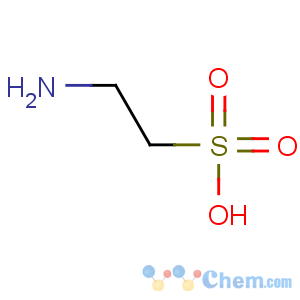Title: Taurine
CAS Registry Number: 107-35-7
CAS Name: 2-Aminoethanesulfonic acid
Molecular Formula: C2H7NO3S
Molecular Weight: 125.15
Percent Composition: C 19.19%, H 5.64%, N 11.19%, O 38.35%, S 25.62%
Line Formula: NH2CH2CH2SO3H
Literature References: Conditionally essential nutrient, important during mammalian development, especially for cells of the cerebellum and retina. Conjugates bile acids, present in most milk (but only minimally in that of dairy cows); occurs also in lungs and flesh extract of oxen, in shark blood, in mussels, in oysters. Isoln from ox bile: Hammarsten,
Z. Physiol. Chem. 32, 456 (1901); from the large muscle of abalone
(Haliotis): Schmidt, Watson,
J. Biol. Chem. 33, 499 (1918). Synthesis starting with 2-bromoethanesulfonate: C. S. Marvel, C. F. Bailey,
Org. Synth. coll. vol. II, 563 (1943). Synthesis by sodium sulfite sulfonation of ethylene chloride followed by ammonolysis with anhydr NH3 or with aq NH3 and ammonium carbonate: Schick, Degering,
Ind. Eng. Chem. 39, 906 (1947). Importance to retinal function in cats: A. R. Rabin
et al., Invest. Ophthalmol. 12, 694 (1973); K. C. Ha
et al., Science 188, 949 (1975); E. L. Berson
et al., Invest. Ophthalmol. 15, 52 (1976); K. C. Hayes,
Can. Vet. J. 23, 2 (1982). Comparison of taurine depletion in humans and other mammals: K. C. Hayes, J. A. Sturman,
Adv. Exp. Med. Biol. 139, 79 (1982). Presence in human milk: G. E. Gaull,
J. Pediatr. Gastroenterol. Nutr. 2, Suppl. 1, 266 (1983);
idem, Acta Paediatr. Scand. Suppl. 296, 38 (1982). Concn in plasma and urine of breast-fed and formula-fed infants: A.-L. J?rvenp??
et al., Pediatrics 70, 221 (1982). Association of retinal dysfunction with low plasma taurine levels in adults: H. S. Geggel
et al., N. Engl. J. Med. 312, 142 (1985). Books:
Taurine, R. Huxtable, A. Barbeau, Eds. (Raven Press, New York, 1975) 480 pp;
Taurine: Nutritional Value and Mechanisms of Action, J. B. Lombardini
et al., Eds. (Plenum Press, New York, 1992) 456 pp.
Properties: Large monoclinic prismatic rods, dec about 300°. pK1¢ 1.5; pK2¢ 8.74. Sol in 15.5 parts of water at 12°. 100 parts of 95% alc dissolve 0.004 parts at 17°. Insol in abs alc.
pKa: pK1¢ 1.5; pK2¢ 8.74
NOTE: Some infant formulas are being reformulated to increase the concn of taurine to that found in human milk,
Chem. Eng. News 62, 22 (July 30, 1984).

